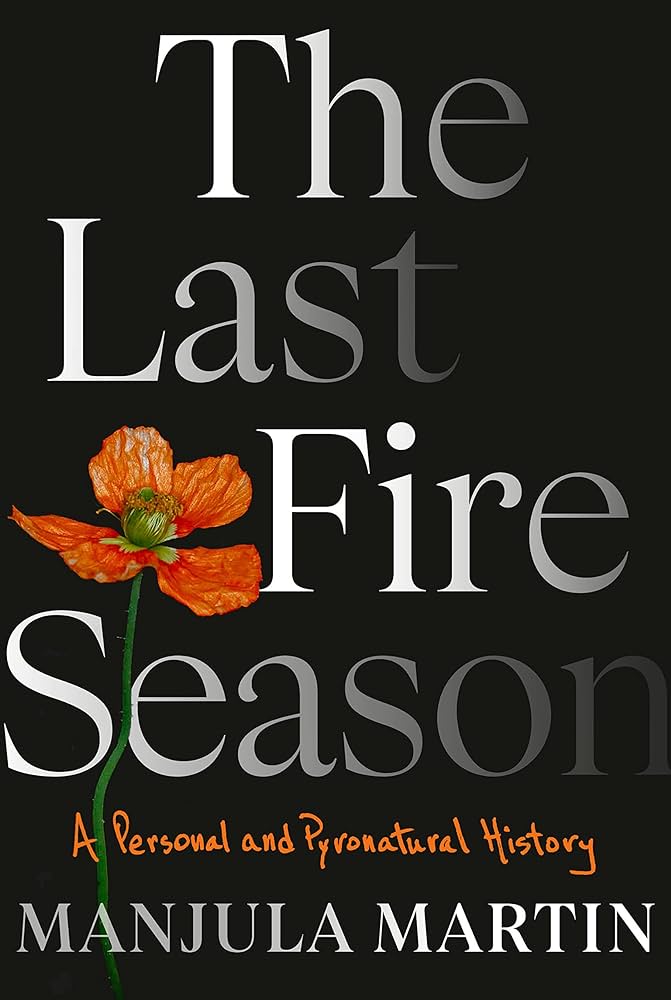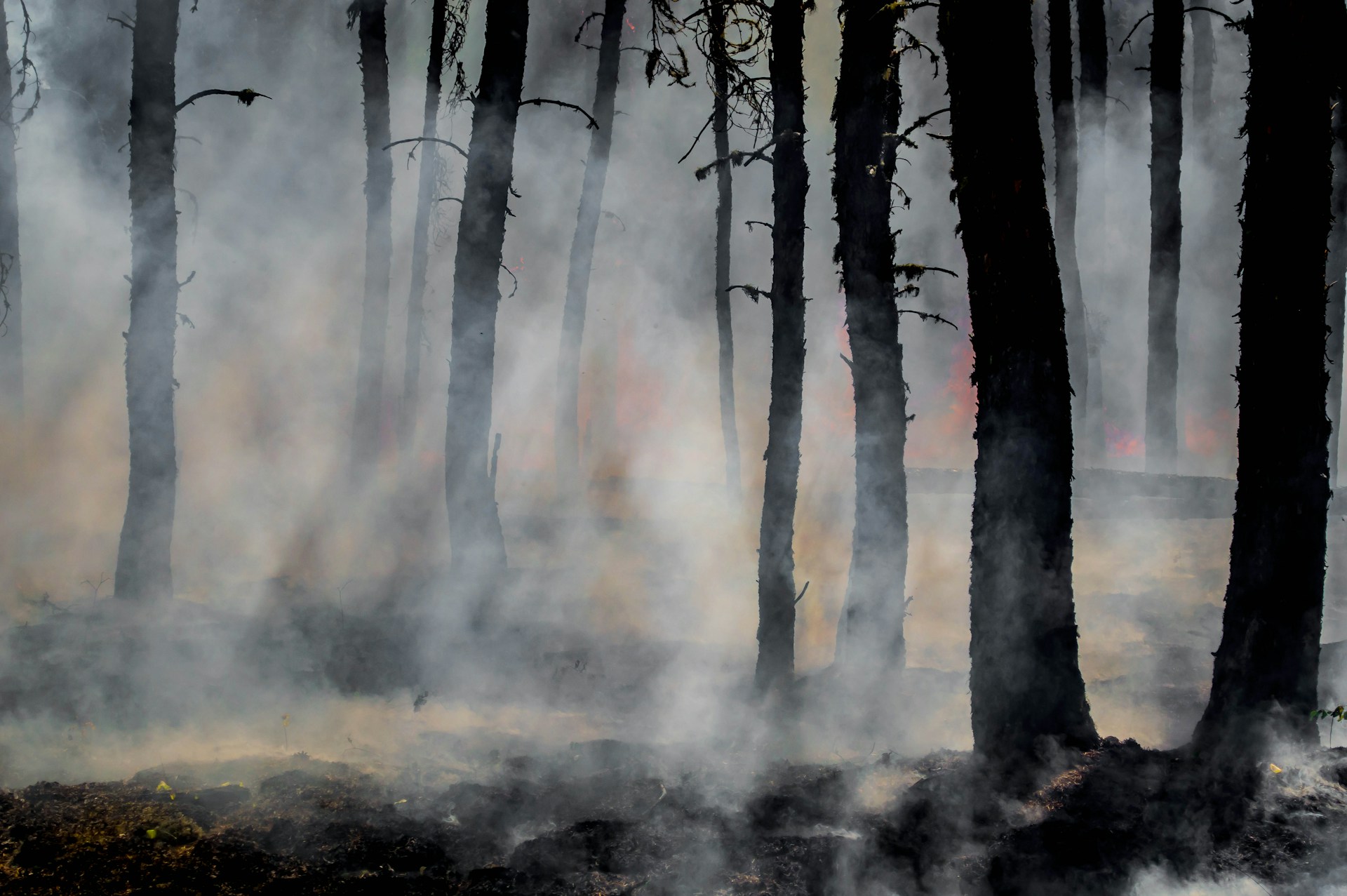by Nicole Yurcaba

The events that inspired me to choose Manjula Martin’s The Last Fire Season: A Personal and Pyronatural History from the ever-growing to-be-reviewed pile in my bedroom is are actually quite frightening. On Wednesday, 20 March, heavy winds brought down power lines and trees in the area in which I live. The live power lines sparked numerous, large brush fires which within a matter of hours brought evacuation notices and desperate calls for manpower and equipment from our local volunteer fire department. So why not choose the book that seems to most resonate with the current situation? I did, and I’m unsure what I expected, but but Manjula Martin’s The Last Fire Season delivered a lot of disappointment.
Martin’s book focuses on the 2020 fires that engulfed Sonoma County after a dry lightning storm ignited hundreds of wildfires across the area. Amid heavy smoke from the fires and social-distancing protocols due to the COVID-19 pandemic, Martin, along with thousands of others, evacuated to areas that, for a time, remained unaffected by the fires. The Last Fire Season is supposed to be a love letter to the landscapes which shape the author’s life, and, for a few pages, it is. However, the dominant narratives of Martin’s book are long, dry historical accounts and ecological studies as well as white privileged whininess about having to evacuate to expensive beach and resort houses while paying attention to smoke and fire alerts. Tucked beneath the cycle of seemingly perpetual whining is, however, an important discussion regarding women’s rights and America’s botched healthcare system, and while, at times, it is difficult to move past the author’s glaring racial and socio-economic privilege during a time when millions were suffering, the book does offer a few unique takes on colonialism’s influence on natural environments.
The Last Fire Season does introduce readers to a new word–solastalgia. It’s a term introduced by Australian professor and environmental activist Glenn Albrecht, who coined the term after observing the displacement of a community besieged by coal mining. Solastalgia refers to “the grief that a person felt when their home environment was irrevocably altered.” Albrecht also described it as “‘a form of homesickness one gets when one is still at home,’” and Martin poses that the term overlaps with the psychological concept of environmental grief. The Last Fire Season is rife with environmental grief, and one might argue that the book is Martin’s own way of expressing her solastalgia. After all, the home abutted by ancient redwoods that she and her partner own in one of California’s more reasonable housing associations is threatened by fire and lingering smoke. At various points in the book, Martin mourns for her garden and the various wildflowers and plants she has painstakingly planted and nurtured on her property. However, other than these brief snippets, Martin’s own relationship with the landscape seems superficial at best.
Nonetheless, The Last Fire Season does, occasionally, redeem itself. Many of Martin’s reflections and narratives in the book depict her struggle with debilitating physical difficulties after an implanted IUD, and the surgery to remove it, resulted in complex and costly surgeries. One of Martin’s deeper reflections occurs when she correlates surviving the experience of her own body to that of trying to survive the evolving ecosystems threatened by climate change. She writes, “To survive the experience of my body, I needed beauty, and I found it in flowers.” She also writes, “The messy diametrics of my body and the ecosystems it touched were to me evidence of connection, not an argument against it.” When Martin poses that “Every summer was hotter than the last, every winter harsher,” these observations parallel the experiences she shares about overcoming her illness and the physical consequences of the botched surgery which debilitated her. Thus, her narrative transforms into that which relates to other environmentalist writers, such as Canada’s Jenna Butler. What offsets the ultimate emotional power of these portions of the book are the often lengthy historical anecdotes and the carefully interjected (economically privileged) reflections about biking for six months across France.
Occasionally, Martin manages to also capture the vehemency and violence boiling over in America during the COVID-19 pandemic. She does so by briefly tackling a topic which will resonate with readers even in 2024–how the far-right panders to disinformation and propaganda. As the fires in Sonoma County and other parts of California raged, Martin writes, “Far right groups began circulating intentional disinformation.” These far-right groups claimed that “antifascists and members of the movement for Black lives” set the fires. An even more terrifying image emerges as Martin continues: “White men with guns and ammo belts slung across their chests roamed evacuation zones, threatening journalists on camera.” However, in Martin’s writing, even nature develops a defiance towards such groups, and some of her most beautiful writing happens as she describes how the “wind pressed on through the night and into the next day.” This essence of perseverance is quietly sprinkled throughout the text, and it becomes more meaningful as readers encounter Martin’s observations about what the fires actually mean, not only for the environment or California in general, but, overall, for the entire globe.
These ideas become more powerful near the book’s conclusion, when Martin writes, “It was a season of death in a year of death in a culture bent on ignoring death, within a national body politic that was consumed with the gobbling up of itself by a death cult called oil, capital, empire.” Martin addresses the larger, federal conflicts and controversies at play in response to COVID in America. She then manages to reflect how that cult-like attitude eventually proliferated the common public–via the abundance of hashtags on handmade signs. Martin observes that the “civilian, offline use of handwritten hashtags” unsettled her because “it framed survival as a consumer experience” since hashtags were for “brands and trends.” Her observation is a subtle stab at the capitalist tendencies inherent in American society, which is seemingly ruled by the latest and greatest consumable brands and trends. Thus, Martin is actually pointing out why a certain swath of the population had difficulty believing the reality of COVID-19. The disease, the pandemic, and particularly the global lockdown that followed, were wrenches thrown into global capitalism’s inner gears since the pandemic required pause and humanity rather than round-the-clock hustle and bustle.
Another aspect of the book that Martin adeptly manages is the end-of-times narratives which have, for many decades, permeated American society, specifically the far-right. She approaches cautiously, introducing readers to facts: “The notion of the end of the world was itself a flexible one: Earth had already experienced five extinction-level events, and it was the start of a sixth.” She provides a new view about a different kind of apocalypse–one that many in the far-right would refuse to acknowledge even if they would take the time to learn about it: the apocalypse of settler colonialism. Martin suggests that the apocalypse of settler colonialism didn’t “exclusively kill people.” Rather, “it transformed the ecologies of the places it struck.” She concludes that “for nonhuman species, apocalypses happened every day: extinction, migration, extirpation, eradication of habitat.” In this, Martin’s work develops a scientific tone which resonates with literature in different genres–like Stephanie Niu’s experimental poetry collection Survived By — tackling the very same issues.
As the book continues, readers encounter Martin’s work develops slightly more resonance with current events as Martin shares her experience of traveling to Israel with her partner, Max. She describes being “shocked, though not surprised” by the “apartheid and racism” she witnessed as “part of the state of Israel’s occupation of Palestine and violence against Palestinian people.” However, the resonance loses merit very quickly. Rather than explicating more about the Israel-Palestine situation and how it relates to Martin’s personal and environmental experiences and relationships, Martin dives into a lengthy, detailed paragraph about how her father left organized belief systems once she and her parents departed the spiritual community where she and her brother had been born.
In many ways, The Last Fire Season could have been half of the length that it is (a bulky 327 pages), but because Martin hashes and rehashes many of the same stories, just in different chapters, the book becomes monotonous and repetitive. Some might argue that this creates a necessary, cyclical tone and structure in the book, which mimics the natural, environmental, human, and biological cycles and patterns about which Martin writes. Nonetheless, because of the repetition, and because of the subtle hypocrisy inherent in Martin’s book, The Last Fire Season does little to spark an interest in, or any empathy for, Martin’s causes.
Nicole Yurcaba (Ukrainian: Нікола Юрцаба–Nikola Yurtsaba) is a Ukrainian (Hutsul/Lemko) American poet and essayist. Her poems and essays have appeared in The Atlanta Review, The Lindenwood Review, Whiskey Island, Raven Chronicles, West Trade Review, Appalachian Heritage, North of Oxford, and many other online and print journals. Nicole teaches poetry workshops for Southern New Hampshire University and is a guest book reviewer for Sage Cigarettes, Tupelo Quarterly, Colorado Review, and The Southern Review of Books.



Add your first comment to this post